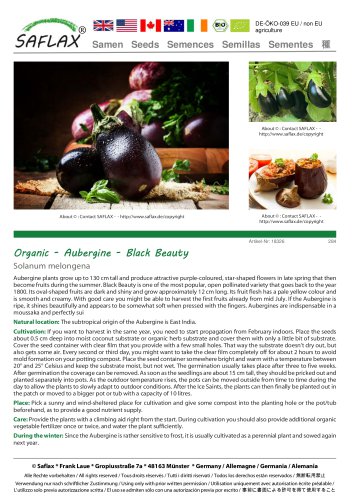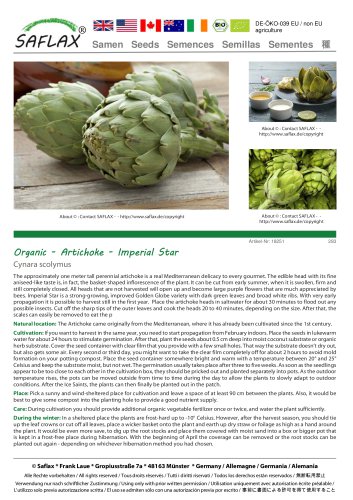
Catalog excerpts

Samen Seeds Semences Semillas Sementes 種 About © : Contact SAFLAX - http://www.saflax.de/copyright About © : Contact SAFLAX - - http://www.saflax.de/copyright About © : Contact SAFLAX - http://www.saflax.de/copyright Organic - Swiss Chard - Rhubarb Beta vulgaris subsp. vulgaris Rhubarb is a high-yielding Swiss chard variety with dark-green, slightly crinkled leaves with carmine red stems and veins. The stems can be prepared on its own by cooking in saltwater and refining - like asparagus - with butter or béchamel sauce. For preparing Swiss chard spinach you may remove the stems and cook the chopped leaves in oil covered by a lid. The spinach becomes Natural location: Swiss chard has already been cultivated by the ancient Greeks. Cultivation: You can start cultivation from January until March in a wind-sheltered cold frame with a fleece cover for frosty nights, or in pot on your windowsill. Plant three seeds per planting hole about 1 cm deep into coconut substrate or organic vegetable substrate. After germination, you can prick the seedlings out leaving only the strongest one. It will take about four to six weeks after seeding until the seedlings have properly developed. A temperature between 15° and 20° Celsius would be ideal for germination. Starting from the end of May, when there are no frosty nights ahead anymore, and as soon as the seedlings have developed a proper rooting, they can be planted out in the open. Provide some underlining/padding with compost and place the seedlings deep enough into the soil so that the roots are covered with about 1 cm of earth. Leave about 40 to 50 cm space between the plants. Place: The plant has high nutrient demand and grows best at a sunny place of the vegetable patch and in well-grounded, nutritious soil with a good water storage capacity. Care: The plant requires watering and nutrition regularly. Water generously, especially on hot days, but avoid water-logging. Weeding and loosening the surrounding soil from time to time will be rewarded by the plant producing a better harvest and flavour. After planting out, you may regularly provide your Broccoli with organic vegetable fertilizer until about two to three weeks before harvesting. During the winter: The plant should be re-seeded every year. © Saflax * Frank Laue * Gropiusstraße 7a * 48163 Münster * Germany / Allemagne / Germania / Alemania Alle Rechte vorbehalten / All rights reserved / Tous droits réservés / Tutti i diritti riservati / Todos los derechos están reservados / 無断転用禁止 Verwendung nur nach schriftlicher Zustimmung / Using only with prior written permission / Utilisation uniquement avec autorisation écrite préalable / L'utilizzo solo previa autorizzazione scritta / El uso se admiten sólo con una autorización previa por
Open the catalog to page 1All MSL GmbH & Co. KG catalogs and technical brochures
-
Organic - Wild Rocket
1 Pages
-
Levant Cotton
1 Pages
-
Indian Cedar
1 Pages
-
Chicory
1 Pages
-
Common Tobacco
1 Pages
-
Sunflower Titan
1 Pages
-
Organic - Squash - Delicata
1 Pages
-
Organic - Florence Fennel
1 Pages
-
Organic - Nettle
1 Pages
-
Organic - Coriander
1 Pages
-
Organic - Chives
1 Pages
-
Organic - Basil Genovese
1 Pages





























